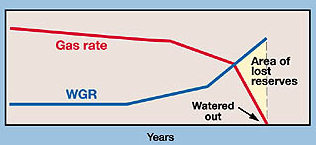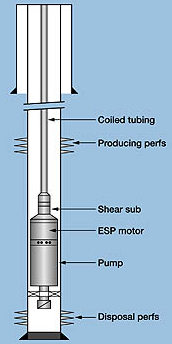CT-deployed dewatering system installs quickly in gas wells
CT-deployed dewatering system installs quickly in gas wellsGerald V. Chalifoux (petrospc@telusplanet.net) and Tony A. Young, Petrospec Engineering Ltd., Edmonton, Alta., Canada Bottom line. A new coiled-tubing-deployed electric submersible pump system addresses liquid loading in shallow gas wells and is up to 50% faster to install than conventional pumping systems. Water encroachment problems. Gas fields in northeast Alberta generally are shallow (less than 3,300 ft) and typically have an active gas / water contact. As wells mature and reservoir pressures decline, the gas / water contact rises and water production increases, Fig. 1.
In many cases, a large percentage of initial gas in place is unrecoverable because of water encroachment. Typical shallow gas wells may be shut in, with unrecovered reserves caused by several factors, including:
Solution. The CT-deployed electrical submersible pump (ESP) system developed by Petrospec Engineering is an economic alternative for unloading water in shallow gas wells. It disposes of produced water downhole, allowing water-free gas production to surface. System improves gas flowrates while extending reserve life and reducing operating expenses. Since produced water is disposed downhole, environmental liabilities associated with handling produced water at surface are eliminated. In high water-to-gas-ratio (WGR) wells, in which gas flowrates are still high enough to lift the water to surface, a downhole separator is added to eliminate surface liquids and associated water disposal costs. This separator also reduces liquid hold up in the wellbore, resulting in increased gas flowrates. Field tests. The CT-conveyed dewatering system was deployed in three wells operated by Amoco Canada: Well 15-8-77-8 W4 (Well 15-8), Well 06-9-77-8 W4 (Well 6-9) and Well 9-14-77-9 W4 (Well 9-14).
Well 15-8. This well was placed on production in 1986 and continued to flow with a stable decline until January 1998. WGR began to steadily increase in 1992. From January to March 1998, the well was kept on line by allowing it to blow to atmospheric conditions through 2-7/8-in. tubing. Gas production was sporadic, averaging less than 500 Mcfd. Water production at this time was near 160 bpd. The well’s production subsequently went to zero, and the well was shut in because of severe liquid loading, Fig. 2. Amoco Canada recompleted the well for downhole disposal in July 1998. The lower Clearwater formation was perforated, and an injectivity test was completed. Test results indicated that injection rates of 700 bpd could be achieved with an injection pressure less than 600 psi. Permeability in the producing interval, up to two Darcys, is typical for the area. The CT-deployed ESP system was installed (Fig. 3) and the pump and packer assembly was landed 4 ft above the disposal perforations. Casing volume between production perforations and packer was 1.8 bbl, accounting for pump and tubing displacement. Start-up was trouble-free with gas production restored to about 1994 rates. The combination of dewatering the wellbore and increasing the flow path for gas in the casing resulted in significantly higher than anticipated gas production rates. System control was tuned, and well equipment operated trouble-free for 125 days. Payout occurred in about one month. The system was shut down in mid-October 1998 when problems were experienced with Amoco’s generator. Using calculations of sump volume and pump cycles, it was determined that the completion interval was producing an estimated 320 bpd of water after installation of the ESP. The produced water was injected into the deeper zone and no water production to surface was observed. Wells 6-9 and 9-14. As a result of the first well’s success, Amoco Canada installed two additional systems in August 1998, Table 1. The wells were prepared by removing 2-3/8-in. production tubing and perforating the disposal zone. Both wells were installed and commissioned in two days. While the CT-deployed systems worked well in disposing of produced water, very little incremental gas was realized. Low gas rates were attributed to geology (wells were located structurally low within the reservoir), formation damage and higher than anticipated gas depletion. After 70 to 80 days of operation, Amoco elected to shut down these two systems because of uneconomic gas flowrates.
Operational advantages. The CT-deployed dewatering system offers several advantages over standard gas completion systems, including:
Lessons learned. The installation in Well 15-8 was an economic success, paying out within a month. Systems installed in Wells 6-9 and 9-14 functioned properly, but were not economic because of reservoir issues. Overall, the systems proved to be 50% faster to install than conventional pumping systems. Key lessons learned from these field applications are:
Acknowledgment Herb Ziegler, Amoco Canada Petroleum Ltd., Edmonton, Alta., and Scott Kiser, Caliber Coil Tubing, Calgary, Alta. The authorsGerald V. Chalifoux is president and senior engineer of Petrospec Engineering Ltd., where he is responsible for design of oil and gas production and process systems, well completions and artificial lift systems. He held previous engineering and management positions at A. Comeau & Associates Ltd., as well as Amoco Canada Petroleum Co. Ltd. Chalifoux earned a BS in petroleum engineering from the University of Alberta. Tony A. Young is technical specialist and operations manager of Petrospec Engineering Ltd., where he is responsible for product design and development, field technical projects and oil and gas optimization products. His previous positions include technical specialist at Secure Oil Tools and senior operator and project facilitator at Imperial Oil Canada Ltd. Young has an educational background as a mining technologist and in geology. Copyright © 1999 World
Oil |
||||||||||||||||||||||||||||||||||||||||||||||||||||||||||||||||||||||||||||||||||||
- Applying ultra-deep LWD resistivity technology successfully in a SAGD operation (May 2019)
- Adoption of wireless intelligent completions advances (May 2019)
- Majors double down as takeaway crunch eases (April 2019)
- What’s new in well logging and formation evaluation (April 2019)
- Qualification of a 20,000-psi subsea BOP: A collaborative approach (February 2019)
- ConocoPhillips’ Greg Leveille sees rapid trajectory of technical advancement continuing (February 2019)




